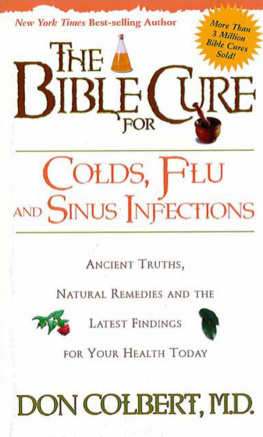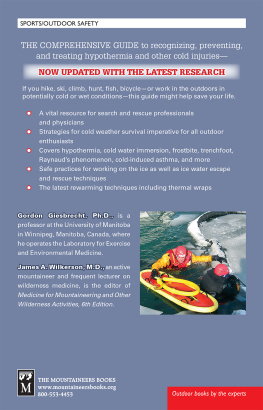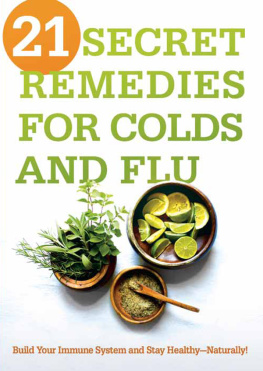How to Prevent and Treat Colds, Flu, Sinusitis, Bronchitis, Strep Throat, and Pneumonia at Any Age
Neil Schachter, M.D.
You have done so much for all of us. You are the glue, the strength and resolve that has held us together as well as the vision that kept us moving forward.
W ELCOME TO
THE C OLD W ARS
T here are three things that I know about Katherine Davis. She is the author of twenty-two romance novels, stands six feet tall in her stockinged feet, and she never, ever calls me unless something is seriously wrong.
I first met Katherine when her husband was hit by a minivan. As he was brought to the emergency room, his lung collapsed and I was called for a consultation. While we were working on Nate, his heart stopped briefly and we had to scramble to get his cardiac system working again. The next time Katherine called, her furnace had had a puff back and she and her family had inhaled oily, black soot. So when she called me again at home late on a rainy spring night, I imagined the worst.
Neil, I cant believe what happened! she began anxiously.
I peppered her with questions: Is Nate all right? Is he short of breath? Is he in pain?
No! No! she exclaimed. Its this awful cold! You doctors can bring people back from the dead. Isnt there anything that you can do for this miserable stuffed nose and sore throat?
I was so relieved that I burst out laughing. Its not funny! she wailed. We had to cancel our trip to Italy because of this stupid cold.
Katherine is hardly unique in her cold or in her sense of frustration. Each year Americans suffer an astonishing 1 billion colds. We spend $5 billion on cold and sniffle remedies. These all-too-common virus infections are responsible for the loss of 50 million workdays and 60 million school days. Influenza, the simple colds evil twin, affects up to 60 million Americans and is fatal to twenty thousand people annually. In fact, influenza and pneumonia together are the sixth leading cause of death in the United States.
The Good Doctors Guide to Colds and Flu will show you how to avoid illness, the most effective approachs to reducing congestion, fever, and discomfort when a cold, flu, or other respiratory infections do strike, and what to do if an infection becomes serious.
We tend to call any illness accompanied by coughs and sneezes a cold, but there are actually six different types of respiratory infections that begin with seemingly similar symptoms. In addition to colds and flu, bronchitis, pneumonia, sore throats, and sinusitis affect different parts of the respiratory system and require individualized strategies for prevention and treatment. For example, Katherine Daviss cold had actually developed into bronchitis, and she needed a short course of bronchodilators to reduce irritability of her airways. If her cold had been treated early and correctly, she could likely have avoided the lung problems that forced cancellation of her trip.
While modern diseases such as SARS and mad cow disease have captured the worlds attention, the history of colds is as old as the history of man. Early Egyptian hieroglyphs depicting cough and cold are found on the walls of ancient buildings. The famous Ebers papyrus offered a potion for cold symptoms called galena that included dry incense and honey. The earliest description of a cold was given by fifth-century B.C. Greek physician Hippocrates, who is considered the father of medicine. Hippocrates carefully described a runny, swollen nose and fever. He did not offer remedies, but he rightly rejected his eras favored approach of bleeding as a cure for colds.
The care of colds, considered a minor problem, was left to homemade concoctions and folk medicine, a tradition that continues today. In the first century, Pliny the Elder recommended kissing the hairy muzzle of a mouse for the relief of cold symptoms. At that same period of time in Rome, Celsus wrote about the common cold and prescribed a more popular remedyflagons of good Italian wine. Wine, warm and spiced, has reappeared as a cold remedy over the centuries and is still used today.
During the fifteenth and sixteenth centuries, hot drinks that raised a sweat were thought to be the perfect antidote for the cold. Ben Franklin declared that fresh air prevented colds, since he observed that colds were contracted by close contact with other cold sufferers. He was also probably the first who dismissed the idea that cold or dampness produced this illness.
Over the centuries the cause of colds and sniffles remained even more elusive. The Greeks thought the symptoms were due to an imbalance of humors, while the Saxons were convinced the disease was due to invisible arrows flying through the air. Among Pueblo Indians, respiratory diseases were thought to be due to serpents and spirits and demons entering the body. The solution was a ceremony in which disease witches were whipped away with eagle plumes.
In the latter half of the nineteenth century, a brilliant French chemist named Louis Pasteur and a dedicated German physician named Robert Koch made a series of discoveries that ushered in the golden age of microbiology. Pasteur, Koch, and the students they trained systematically isolated and identified the causes of the major killer diseases. Typhus, typhoid fever, tuberculosis, syphilis, and even leprosy were no longer mysteriesbut the cause of the common cold was still unknown. It took two world wars and a cataclysmic influenza pandemic for scientists in England and the United States to persuade officials of the need to study these widespread ailments.
Their commitment led to the creation of the Common Cold Unit, located in a remote corner of England near Salisbury. The goals of this unit were both simple and ambitious: to discover the causes of colds, understand their transmission, and develop vaccines and cures.
Over the next fifty years, the scientists of the unit along with their human volunteers identified eight categories of colds and isolated over two hundred different types of viruses. They learned how colds were spread, why stress can affect immunity, and identified links between weather and infection. But both the vaccine and the cure they sought eluded them, and in 1996 the Common Cold Unit was disbanded.
Influenza, the colds evil twin, has an equally long and interesting history. The term influenza was first applied to the disease during an epidemic that occurred in Florence in 1580. The name is an Italian word meaning influence, a referral to the deleterious influence of the stars on the welfare of humans. Writing in 1659 regarding a widespread illness, Dr. Thomas Wyle described a troublesome cough, a feverish distemper, and a grievous pain in the back and limbs. The seventeenth-century physician, like most medical experts of his era, blamed the blast of stars for the illness.

![Neil Schachter The Good Doctors Guide to Colds and Flu [Updated Edition]: How to Prevent and Treat Colds, Flu, Sinusitis, Bronchitis, Strep Throat, and Pneumonia at Any Age](/uploads/posts/book/256863/thumbs/neil-schachter-the-good-doctor-s-guide-to-colds.jpg)







